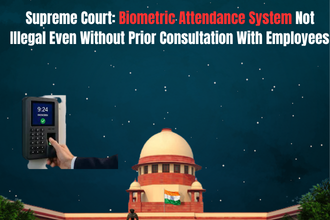The Supreme Court of India recently delivered a significant judgment clarifying the legality of introducing a Biometric Attendance System (BAS) in government offices. The Court held that the implementation of a biometric attendance mechanism is not illegal merely because employees were not consulted beforehand. The ruling came in the appeal filed by the Union of India against an order of the Odisha High Court which had earlier quashed the introduction of BAS in the Office of the Principal Accountant General (A&E), Odisha.
This judgment is important in the context of workplace administration, governance reforms, transparency, and digital systems being adopted across public sector offices.
Background of the Case
The controversy began when the Principal Accountant General’s Office in Odisha issued three circulars—dated July 1, 2013, October 22, 2013, and November 6, 2013—to introduce a Biometric Attendance System for its staff. The aim was to ensure punctuality, transparency, and accuracy in attendance monitoring.
However, a group of employees challenged this move before the Central Administrative Tribunal (CAT). Their primary argument was that they were not consulted before implementing the biometric system and that this lack of consultation was inconsistent with guidelines allegedly contained in Swamy’s Complete Manual on Establishment and Administration used in Central Government offices.
The CAT dismissed the employees’ challenge, supporting the government’s decision. Dissatisfied, the employees approached the Orissa High Court, which reversed the CAT order and quashed the circulars introducing the BAS. The High Court observed that the implementation was flawed due to lack of prior consultation with the staff.
The Union of India then appealed to the Supreme Court.
Arguments Before the Supreme Court
Arguments by the Union of India (Appellant)
- The Union contended that Swamy’s Manual is only a guiding reference and not a binding statutory rulebook.
- The Office of the Principal Accountant General (A&E), Odisha did not violate any existing service rule by introducing the biometric system.
- The purpose of BAS is to enhance administrative efficiency and benefits all stakeholders, including employees.
Arguments by the Employees (Respondents)
Interestingly, when the matter reached the Supreme Court, the employees did not oppose the biometric system anymore. They admitted that BAS is in their interest, improves transparency, and promotes workplace discipline.
Supreme Court’s Observations and Findings
The Supreme Court set aside the High Court judgment, holding that:
“Merely for the reason that the employees were not consulted before introducing the Biometric Attendance System does not render the system illegal.”
The Court highlighted that consultation is not a mandatory precondition unless specifically provided for in service rules. Since the employees themselves had no substantive objection to BAS, the Court held that there was no surviving controversy.
The Court thus allowed the department to proceed with implementing the BAS.
Key Takeaways from the Judgment
1. Biometric Attendance System Is Legal
The Court clarified that introducing BAS in government offices is valid, provided there is no conflict with statutory rules or constitutional provisions.
2. Consultation with Employees Is Not Mandatory
Unless specifically mandated by service rules, the government is not obliged to hold consultations before bringing administrative reforms.
3. Objective of Efficiency and Transparency Matters
The Court recognized that BAS promotes:
- Workplace discipline
- Uniformity in attendance records
- Reduction of proxy attendance
- Transparency in functioning
4. No Prejudice to Employee Rights
Since employees agreed that BAS is beneficial and does not harm their rights, the issue lost significance.
Impact of the Judgment
This ruling comes at a time when many government and public institutions across India are shifting toward digital administration and e-governance platforms. Biometric attendance is becoming increasingly common, especially after concerns about workplace discipline and fake attendance records.
The judgment reinforces the government’s power to modernize office administration without being hindered by procedural objections.
Potential Wider Implications:
- Government agencies can now introduce digital attendance systems more confidently.
- Employees’ consent, though desirable for management harmony, is not a legal necessity unless law requires otherwise.
- Judicial support strengthens administrative reforms and e-governance initiatives.
Why Biometric Attendance Matters
The Biometric Attendance System records fingerprints or face recognition data to mark attendance. Key benefits include:
- Accuracy: Eliminates manual or proxy attendance.
- Efficiency: Automatic record generation saves administrative work.
- Transparency: Helps evaluate punctuality and working hours.
- Accountability: Encourages discipline and responsibility.
With increased focus on efficient governance, BAS aligns with the government’s objective of Digital India and modern office culture.
Conclusion
The Supreme Court’s ruling in Union of India v. Dilip Kumar Rout & Others is a progressive step toward strengthening administrative efficiency and technological upgrades in government offices. The Court rightly emphasized that a reform beneficial to the system and stakeholders cannot be invalidated merely because employees were not consulted beforehand.
By upholding the legality of BAS, the Court has facilitated transparency, discipline, and digital governance in public institutions.
Also Read



